HI5013: Analysis of the Role of Corporate Social Responsibility
VerifiedAdded on 2022/09/28
|10
|1952
|23
Report
AI Summary
This report provides an in-depth analysis of the role of Corporate Social Responsibility (CSR) in contemporary business environments. It begins by defining CSR as a self-regulating business model that emphasizes ethical, sustainable, and socially accountable practices. The report then explores various benefits of CSR, including cost savings through efficient resource management (e.g., reduced packaging and energy consumption), improved brand perception and increased brand awareness, enhanced employee loyalty and motivation, long-term financial success through sustainable practices, and competitive advantages. The report uses examples like General Mills and Mercedes-Benz to illustrate these points. The conclusion emphasizes that effective CSR initiatives require careful planning and consideration of challenges, ultimately leading to improved organizational reputation, financial stability, and positive relationships with stakeholders.

Running head: ANALYSIS THE ROLE OF CORPORATE SOCIAL RESPONSIBILITY
ANALYSIS THE ROLE OF CORPORATE SOCIAL RESPONSIBILITY
Name of the student:
Name of the university:
Author Note:
ANALYSIS THE ROLE OF CORPORATE SOCIAL RESPONSIBILITY
Name of the student:
Name of the university:
Author Note:
Paraphrase This Document
Need a fresh take? Get an instant paraphrase of this document with our AI Paraphraser
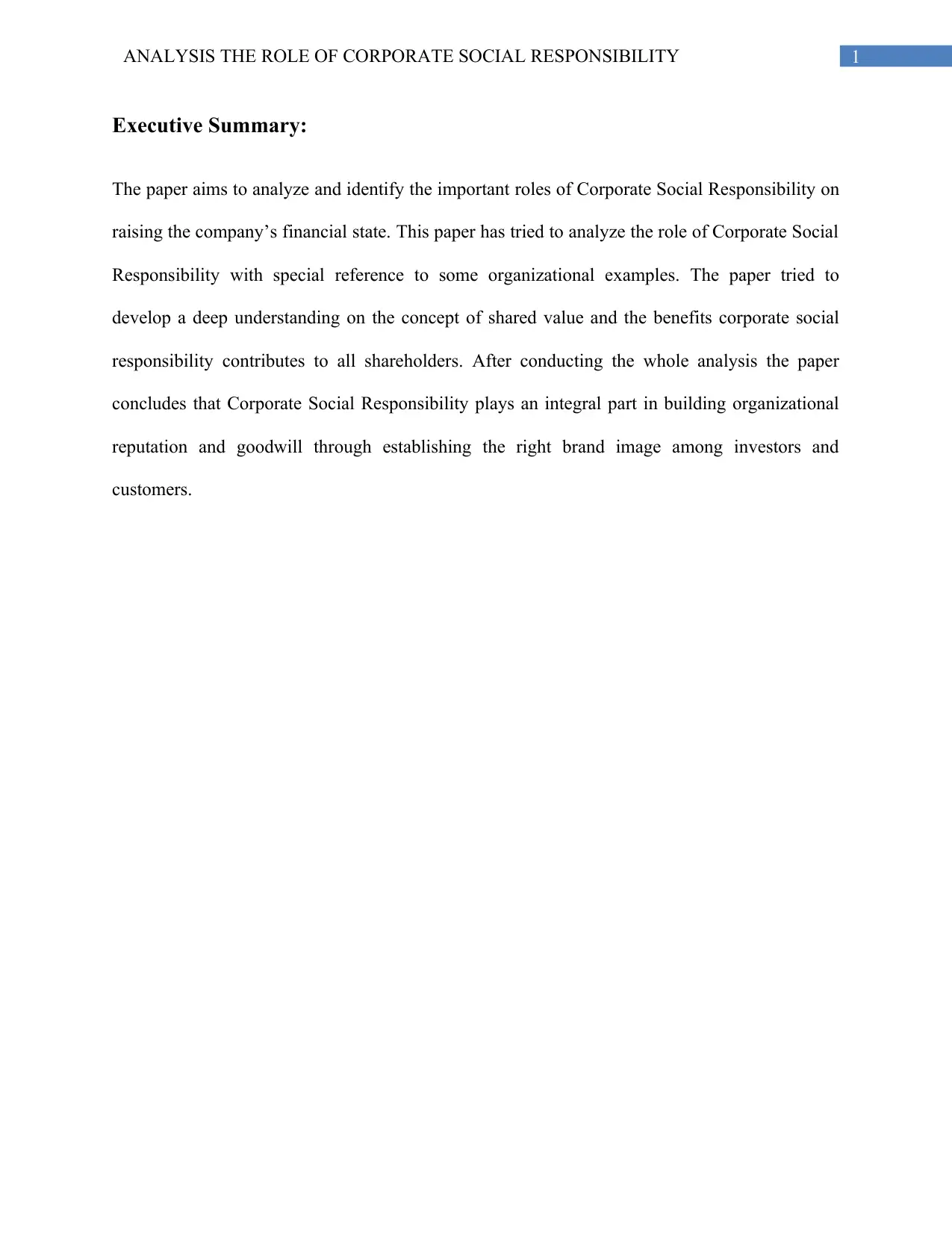
1ANALYSIS THE ROLE OF CORPORATE SOCIAL RESPONSIBILITY
Executive Summary:
The paper aims to analyze and identify the important roles of Corporate Social Responsibility on
raising the company’s financial state. This paper has tried to analyze the role of Corporate Social
Responsibility with special reference to some organizational examples. The paper tried to
develop a deep understanding on the concept of shared value and the benefits corporate social
responsibility contributes to all shareholders. After conducting the whole analysis the paper
concludes that Corporate Social Responsibility plays an integral part in building organizational
reputation and goodwill through establishing the right brand image among investors and
customers.
Executive Summary:
The paper aims to analyze and identify the important roles of Corporate Social Responsibility on
raising the company’s financial state. This paper has tried to analyze the role of Corporate Social
Responsibility with special reference to some organizational examples. The paper tried to
develop a deep understanding on the concept of shared value and the benefits corporate social
responsibility contributes to all shareholders. After conducting the whole analysis the paper
concludes that Corporate Social Responsibility plays an integral part in building organizational
reputation and goodwill through establishing the right brand image among investors and
customers.

2ANALYSIS THE ROLE OF CORPORATE SOCIAL RESPONSIBILITY
Table of Contents
Introduction:....................................................................................................................................3
Discussion:.......................................................................................................................................4
The Role of Corporate Social Responsibility:.............................................................................4
1. Cost Saving Benefits:...........................................................................................................4
3. Brand Perception Benefits:...................................................................................................5
4. Long Term Financial Success:..............................................................................................5
5. Competitive Advantage:.......................................................................................................6
6. Improved public image:........................................................................................................6
Conclusion:......................................................................................................................................7
References:......................................................................................................................................8
Table of Contents
Introduction:....................................................................................................................................3
Discussion:.......................................................................................................................................4
The Role of Corporate Social Responsibility:.............................................................................4
1. Cost Saving Benefits:...........................................................................................................4
3. Brand Perception Benefits:...................................................................................................5
4. Long Term Financial Success:..............................................................................................5
5. Competitive Advantage:.......................................................................................................6
6. Improved public image:........................................................................................................6
Conclusion:......................................................................................................................................7
References:......................................................................................................................................8
⊘ This is a preview!⊘
Do you want full access?
Subscribe today to unlock all pages.

Trusted by 1+ million students worldwide
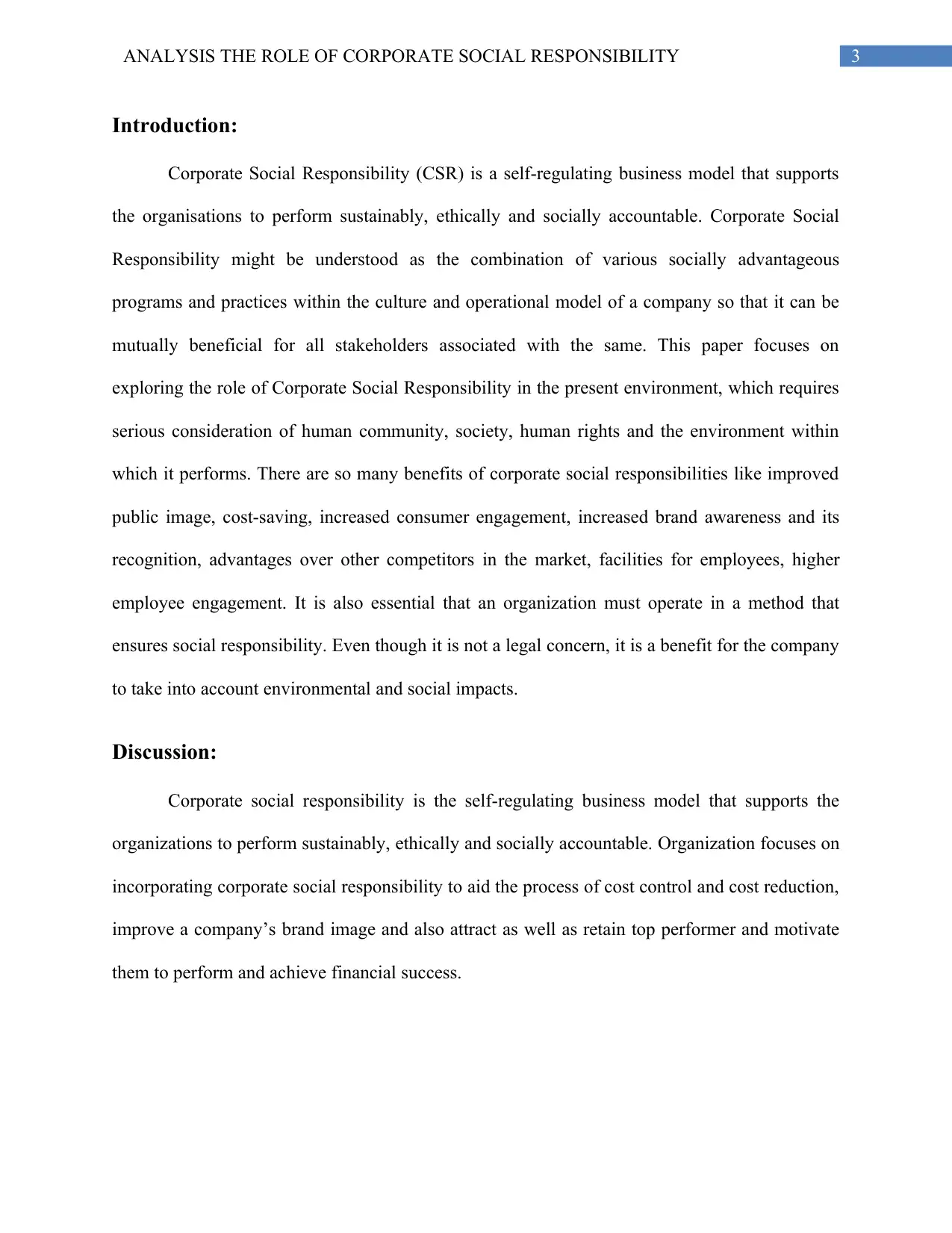
3ANALYSIS THE ROLE OF CORPORATE SOCIAL RESPONSIBILITY
Introduction:
Corporate Social Responsibility (CSR) is a self-regulating business model that supports
the organisations to perform sustainably, ethically and socially accountable. Corporate Social
Responsibility might be understood as the combination of various socially advantageous
programs and practices within the culture and operational model of a company so that it can be
mutually beneficial for all stakeholders associated with the same. This paper focuses on
exploring the role of Corporate Social Responsibility in the present environment, which requires
serious consideration of human community, society, human rights and the environment within
which it performs. There are so many benefits of corporate social responsibilities like improved
public image, cost-saving, increased consumer engagement, increased brand awareness and its
recognition, advantages over other competitors in the market, facilities for employees, higher
employee engagement. It is also essential that an organization must operate in a method that
ensures social responsibility. Even though it is not a legal concern, it is a benefit for the company
to take into account environmental and social impacts.
Discussion:
Corporate social responsibility is the self-regulating business model that supports the
organizations to perform sustainably, ethically and socially accountable. Organization focuses on
incorporating corporate social responsibility to aid the process of cost control and cost reduction,
improve a company’s brand image and also attract as well as retain top performer and motivate
them to perform and achieve financial success.
Introduction:
Corporate Social Responsibility (CSR) is a self-regulating business model that supports
the organisations to perform sustainably, ethically and socially accountable. Corporate Social
Responsibility might be understood as the combination of various socially advantageous
programs and practices within the culture and operational model of a company so that it can be
mutually beneficial for all stakeholders associated with the same. This paper focuses on
exploring the role of Corporate Social Responsibility in the present environment, which requires
serious consideration of human community, society, human rights and the environment within
which it performs. There are so many benefits of corporate social responsibilities like improved
public image, cost-saving, increased consumer engagement, increased brand awareness and its
recognition, advantages over other competitors in the market, facilities for employees, higher
employee engagement. It is also essential that an organization must operate in a method that
ensures social responsibility. Even though it is not a legal concern, it is a benefit for the company
to take into account environmental and social impacts.
Discussion:
Corporate social responsibility is the self-regulating business model that supports the
organizations to perform sustainably, ethically and socially accountable. Organization focuses on
incorporating corporate social responsibility to aid the process of cost control and cost reduction,
improve a company’s brand image and also attract as well as retain top performer and motivate
them to perform and achieve financial success.
Paraphrase This Document
Need a fresh take? Get an instant paraphrase of this document with our AI Paraphraser

4ANALYSIS THE ROLE OF CORPORATE SOCIAL RESPONSIBILITY
The Role of Corporate Social Responsibility:
1. Cost Saving Benefits:
Significant changes in sustainability, such as using a lesser amount of packaging, will
support the reduction of production. By developing and establishing products that use limited
energy and less packaging, reduce utility bills and raw material cost and would lead to a sudden
decrease in the production costs, which would, in turn, use limited energy. (Dijkman etal. 2015).
For instance, one such example that can be taken into consideration would be that of General
Mills. It is on the route of reducing its energy by more than 15%. The company also aims to
ensure the cost-saving benefits by growing efficiency and by expanding its business with the
help of lower budgets. (Azzimonti, Battaglini and Coate 2016).
2. Increased Employee Loyalty:
Corporate social responsibility helps to attract and retain the right talent in their company.
The employee often looks for employees that demonstrate ethical value and behavior that line up
with their own. The firm observed that the different variety of organizations saw employee’s
honesty, loyalty and motivation increase after involving them in corporate social responsibility
initiatives. These companies assumed that they were capable of obtaining talented employees.
(Lee etal. 2013). Corporate Social Responsibility tries to work for betterment of people as well
as the environment in general including the employees within the organization. This provides the
employees with the sense of getting benefit and helps to establish connectivity and familiarity
with the organization. Thus, Corporate Social Responsibility develops loyalty among the
employees towards the organization.
The Role of Corporate Social Responsibility:
1. Cost Saving Benefits:
Significant changes in sustainability, such as using a lesser amount of packaging, will
support the reduction of production. By developing and establishing products that use limited
energy and less packaging, reduce utility bills and raw material cost and would lead to a sudden
decrease in the production costs, which would, in turn, use limited energy. (Dijkman etal. 2015).
For instance, one such example that can be taken into consideration would be that of General
Mills. It is on the route of reducing its energy by more than 15%. The company also aims to
ensure the cost-saving benefits by growing efficiency and by expanding its business with the
help of lower budgets. (Azzimonti, Battaglini and Coate 2016).
2. Increased Employee Loyalty:
Corporate social responsibility helps to attract and retain the right talent in their company.
The employee often looks for employees that demonstrate ethical value and behavior that line up
with their own. The firm observed that the different variety of organizations saw employee’s
honesty, loyalty and motivation increase after involving them in corporate social responsibility
initiatives. These companies assumed that they were capable of obtaining talented employees.
(Lee etal. 2013). Corporate Social Responsibility tries to work for betterment of people as well
as the environment in general including the employees within the organization. This provides the
employees with the sense of getting benefit and helps to establish connectivity and familiarity
with the organization. Thus, Corporate Social Responsibility develops loyalty among the
employees towards the organization.
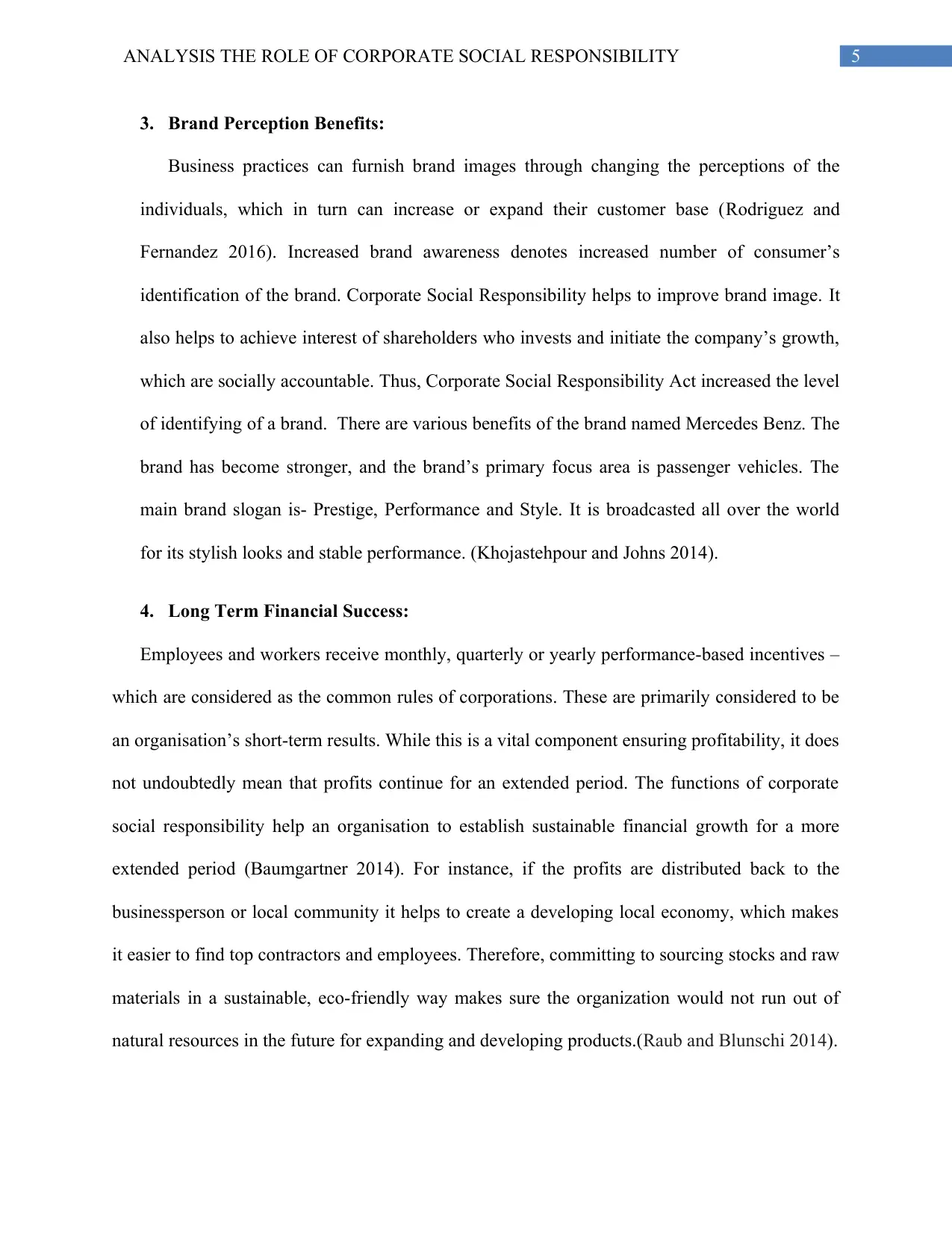
5ANALYSIS THE ROLE OF CORPORATE SOCIAL RESPONSIBILITY
3. Brand Perception Benefits:
Business practices can furnish brand images through changing the perceptions of the
individuals, which in turn can increase or expand their customer base (Rodriguez and
Fernandez 2016). Increased brand awareness denotes increased number of consumer’s
identification of the brand. Corporate Social Responsibility helps to improve brand image. It
also helps to achieve interest of shareholders who invests and initiate the company’s growth,
which are socially accountable. Thus, Corporate Social Responsibility Act increased the level
of identifying of a brand. There are various benefits of the brand named Mercedes Benz. The
brand has become stronger, and the brand’s primary focus area is passenger vehicles. The
main brand slogan is- Prestige, Performance and Style. It is broadcasted all over the world
for its stylish looks and stable performance. (Khojastehpour and Johns 2014).
4. Long Term Financial Success:
Employees and workers receive monthly, quarterly or yearly performance-based incentives –
which are considered as the common rules of corporations. These are primarily considered to be
an organisation’s short-term results. While this is a vital component ensuring profitability, it does
not undoubtedly mean that profits continue for an extended period. The functions of corporate
social responsibility help an organisation to establish sustainable financial growth for a more
extended period (Baumgartner 2014). For instance, if the profits are distributed back to the
businessperson or local community it helps to create a developing local economy, which makes
it easier to find top contractors and employees. Therefore, committing to sourcing stocks and raw
materials in a sustainable, eco-friendly way makes sure the organization would not run out of
natural resources in the future for expanding and developing products.(Raub and Blunschi 2014).
3. Brand Perception Benefits:
Business practices can furnish brand images through changing the perceptions of the
individuals, which in turn can increase or expand their customer base (Rodriguez and
Fernandez 2016). Increased brand awareness denotes increased number of consumer’s
identification of the brand. Corporate Social Responsibility helps to improve brand image. It
also helps to achieve interest of shareholders who invests and initiate the company’s growth,
which are socially accountable. Thus, Corporate Social Responsibility Act increased the level
of identifying of a brand. There are various benefits of the brand named Mercedes Benz. The
brand has become stronger, and the brand’s primary focus area is passenger vehicles. The
main brand slogan is- Prestige, Performance and Style. It is broadcasted all over the world
for its stylish looks and stable performance. (Khojastehpour and Johns 2014).
4. Long Term Financial Success:
Employees and workers receive monthly, quarterly or yearly performance-based incentives –
which are considered as the common rules of corporations. These are primarily considered to be
an organisation’s short-term results. While this is a vital component ensuring profitability, it does
not undoubtedly mean that profits continue for an extended period. The functions of corporate
social responsibility help an organisation to establish sustainable financial growth for a more
extended period (Baumgartner 2014). For instance, if the profits are distributed back to the
businessperson or local community it helps to create a developing local economy, which makes
it easier to find top contractors and employees. Therefore, committing to sourcing stocks and raw
materials in a sustainable, eco-friendly way makes sure the organization would not run out of
natural resources in the future for expanding and developing products.(Raub and Blunschi 2014).
⊘ This is a preview!⊘
Do you want full access?
Subscribe today to unlock all pages.

Trusted by 1+ million students worldwide

6ANALYSIS THE ROLE OF CORPORATE SOCIAL RESPONSIBILITY
5. Competitive Advantage:
By embracing corporate social responsibility, the organization must stand out from its
competitors in its field. The company should develop itself as a brand, devoted to going through
various stages by acknowledging environmental and social issues (David and David 2013). For
example, Daimler Inc., which is regarded as a subsidiary of Mercedes, has various other brands
like Public utility buses, business units, trucks, and vans services, which have helped, provide
Mercedes in different businesses for their establishment Mercedes has establishment. It has also
helped them get constant support like technological guidance, dealership management and
financing. Mercedes has started their brand and positioning their marketing and sales plans with
customer demand requirements it means they are developing themselves from its product basis to
consumer-centric company, which delivers most stylish products to the individuals, which help
in defining a certain amount of class (Herrera 2015).
6. Improved public image:
This is an essential factor as buyers assess the company’s brand image and decide
whether they want to purchase from the company or brand. For instance or example if
employees cater to the needs of the customers and behave in a proper manner the customer's
loyalty would increase which would create a direct impact on the public which would expand
the customers base eventually. Customers would be satisfied, and this would improve the
brand’s public image. (Hoeve, Jansen and Roodbal 2014).
Conclusion:
Therefore, from the above discussion, it can be concluded that developed skills are
required for the managers in making the definite plans and these plans must pay attention on all
the difficulties that the managers and the organization usually might confront during time of
5. Competitive Advantage:
By embracing corporate social responsibility, the organization must stand out from its
competitors in its field. The company should develop itself as a brand, devoted to going through
various stages by acknowledging environmental and social issues (David and David 2013). For
example, Daimler Inc., which is regarded as a subsidiary of Mercedes, has various other brands
like Public utility buses, business units, trucks, and vans services, which have helped, provide
Mercedes in different businesses for their establishment Mercedes has establishment. It has also
helped them get constant support like technological guidance, dealership management and
financing. Mercedes has started their brand and positioning their marketing and sales plans with
customer demand requirements it means they are developing themselves from its product basis to
consumer-centric company, which delivers most stylish products to the individuals, which help
in defining a certain amount of class (Herrera 2015).
6. Improved public image:
This is an essential factor as buyers assess the company’s brand image and decide
whether they want to purchase from the company or brand. For instance or example if
employees cater to the needs of the customers and behave in a proper manner the customer's
loyalty would increase which would create a direct impact on the public which would expand
the customers base eventually. Customers would be satisfied, and this would improve the
brand’s public image. (Hoeve, Jansen and Roodbal 2014).
Conclusion:
Therefore, from the above discussion, it can be concluded that developed skills are
required for the managers in making the definite plans and these plans must pay attention on all
the difficulties that the managers and the organization usually might confront during time of
Paraphrase This Document
Need a fresh take? Get an instant paraphrase of this document with our AI Paraphraser

7ANALYSIS THE ROLE OF CORPORATE SOCIAL RESPONSIBILITY
taking this initiative. The managers also required to consider all the challenges involved and
other roles important for ensuring the effective Corporate Social Responsibility initiative. From
the above discussion it can be stated that Corporate Social Responsibility enables a company to
be socially responsible which in turn helps it to retain as well as attract talent, establish employee
loyalty and harmonious cooperative organizational culture which in turn can lead towards the
better performance and productivity. Corporate Social Responsibility is the kind of initiative that
not only can improve the reputation, image but also ensure the financial stability of a particular
organization. Corporate Social Responsibility is also effective in facilitating the environmental
development, which demands the great concern for curing the environment from in recent
degraded and polluted state. Thus, Corporate Social Responsibility becomes an inevitable
initiative to implement for the organization in ensuring the positive publicity, good relationship
with customers, employees and other key players in business, which in turn leads towards overall
organizational growth and development.
taking this initiative. The managers also required to consider all the challenges involved and
other roles important for ensuring the effective Corporate Social Responsibility initiative. From
the above discussion it can be stated that Corporate Social Responsibility enables a company to
be socially responsible which in turn helps it to retain as well as attract talent, establish employee
loyalty and harmonious cooperative organizational culture which in turn can lead towards the
better performance and productivity. Corporate Social Responsibility is the kind of initiative that
not only can improve the reputation, image but also ensure the financial stability of a particular
organization. Corporate Social Responsibility is also effective in facilitating the environmental
development, which demands the great concern for curing the environment from in recent
degraded and polluted state. Thus, Corporate Social Responsibility becomes an inevitable
initiative to implement for the organization in ensuring the positive publicity, good relationship
with customers, employees and other key players in business, which in turn leads towards overall
organizational growth and development.
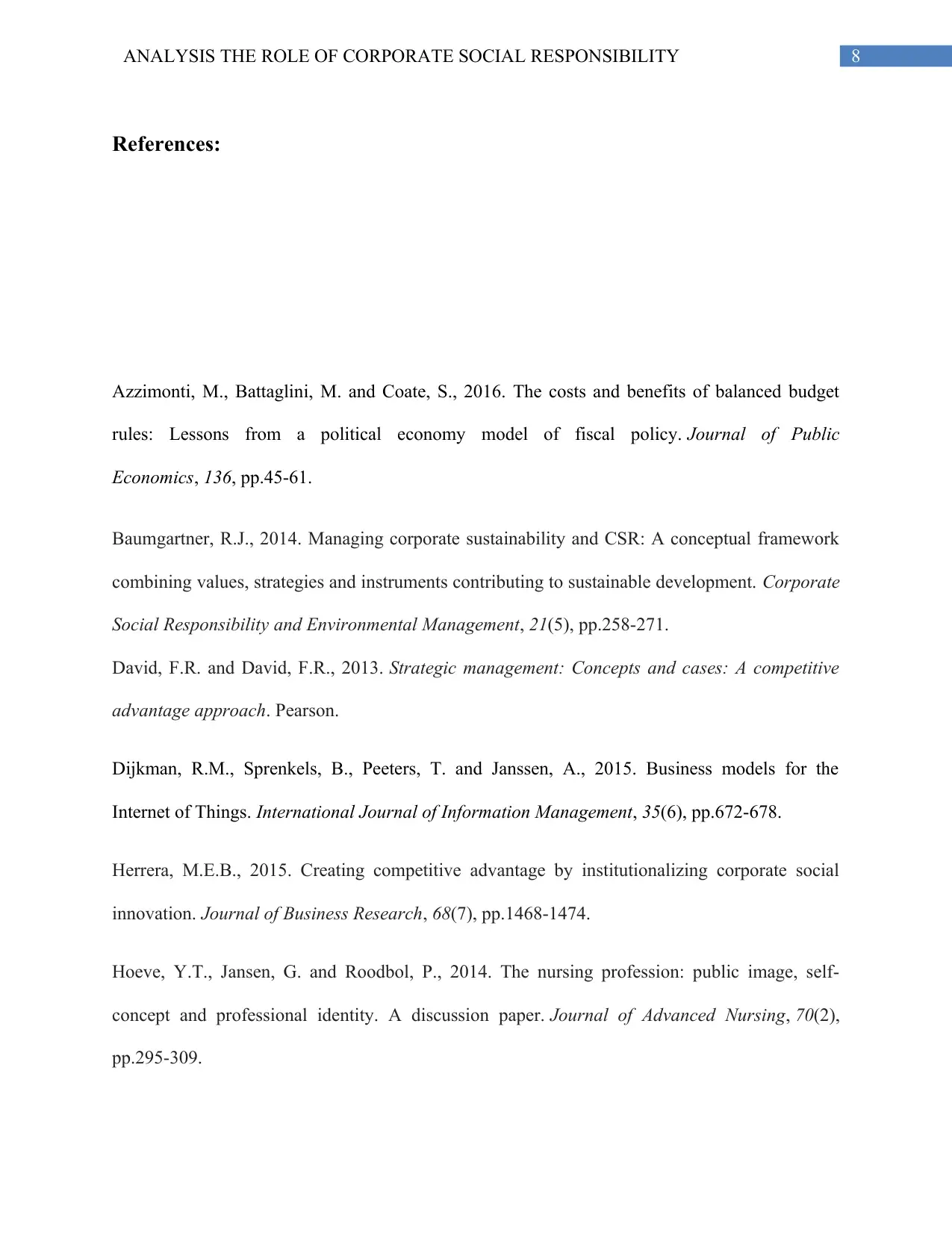
8ANALYSIS THE ROLE OF CORPORATE SOCIAL RESPONSIBILITY
References:
Azzimonti, M., Battaglini, M. and Coate, S., 2016. The costs and benefits of balanced budget
rules: Lessons from a political economy model of fiscal policy. Journal of Public
Economics, 136, pp.45-61.
Baumgartner, R.J., 2014. Managing corporate sustainability and CSR: A conceptual framework
combining values, strategies and instruments contributing to sustainable development. Corporate
Social Responsibility and Environmental Management, 21(5), pp.258-271.
David, F.R. and David, F.R., 2013. Strategic management: Concepts and cases: A competitive
advantage approach. Pearson.
Dijkman, R.M., Sprenkels, B., Peeters, T. and Janssen, A., 2015. Business models for the
Internet of Things. International Journal of Information Management, 35(6), pp.672-678.
Herrera, M.E.B., 2015. Creating competitive advantage by institutionalizing corporate social
innovation. Journal of Business Research, 68(7), pp.1468-1474.
Hoeve, Y.T., Jansen, G. and Roodbol, P., 2014. The nursing profession: public image, self‐
concept and professional identity. A discussion paper. Journal of Advanced Nursing, 70(2),
pp.295-309.
References:
Azzimonti, M., Battaglini, M. and Coate, S., 2016. The costs and benefits of balanced budget
rules: Lessons from a political economy model of fiscal policy. Journal of Public
Economics, 136, pp.45-61.
Baumgartner, R.J., 2014. Managing corporate sustainability and CSR: A conceptual framework
combining values, strategies and instruments contributing to sustainable development. Corporate
Social Responsibility and Environmental Management, 21(5), pp.258-271.
David, F.R. and David, F.R., 2013. Strategic management: Concepts and cases: A competitive
advantage approach. Pearson.
Dijkman, R.M., Sprenkels, B., Peeters, T. and Janssen, A., 2015. Business models for the
Internet of Things. International Journal of Information Management, 35(6), pp.672-678.
Herrera, M.E.B., 2015. Creating competitive advantage by institutionalizing corporate social
innovation. Journal of Business Research, 68(7), pp.1468-1474.
Hoeve, Y.T., Jansen, G. and Roodbol, P., 2014. The nursing profession: public image, self‐
concept and professional identity. A discussion paper. Journal of Advanced Nursing, 70(2),
pp.295-309.
⊘ This is a preview!⊘
Do you want full access?
Subscribe today to unlock all pages.

Trusted by 1+ million students worldwide
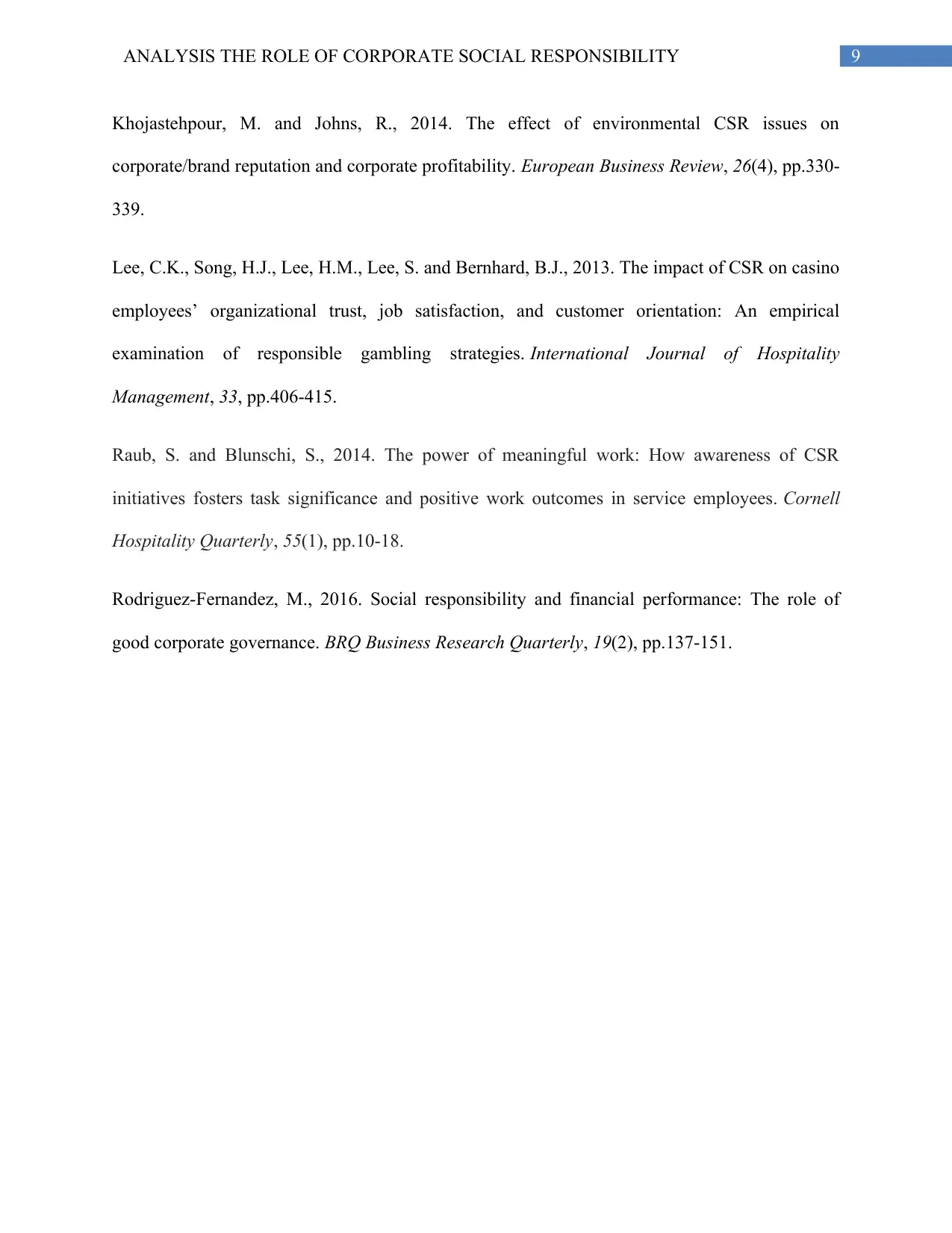
9ANALYSIS THE ROLE OF CORPORATE SOCIAL RESPONSIBILITY
Khojastehpour, M. and Johns, R., 2014. The effect of environmental CSR issues on
corporate/brand reputation and corporate profitability. European Business Review, 26(4), pp.330-
339.
Lee, C.K., Song, H.J., Lee, H.M., Lee, S. and Bernhard, B.J., 2013. The impact of CSR on casino
employees’ organizational trust, job satisfaction, and customer orientation: An empirical
examination of responsible gambling strategies. International Journal of Hospitality
Management, 33, pp.406-415.
Raub, S. and Blunschi, S., 2014. The power of meaningful work: How awareness of CSR
initiatives fosters task significance and positive work outcomes in service employees. Cornell
Hospitality Quarterly, 55(1), pp.10-18.
Rodriguez-Fernandez, M., 2016. Social responsibility and financial performance: The role of
good corporate governance. BRQ Business Research Quarterly, 19(2), pp.137-151.
Khojastehpour, M. and Johns, R., 2014. The effect of environmental CSR issues on
corporate/brand reputation and corporate profitability. European Business Review, 26(4), pp.330-
339.
Lee, C.K., Song, H.J., Lee, H.M., Lee, S. and Bernhard, B.J., 2013. The impact of CSR on casino
employees’ organizational trust, job satisfaction, and customer orientation: An empirical
examination of responsible gambling strategies. International Journal of Hospitality
Management, 33, pp.406-415.
Raub, S. and Blunschi, S., 2014. The power of meaningful work: How awareness of CSR
initiatives fosters task significance and positive work outcomes in service employees. Cornell
Hospitality Quarterly, 55(1), pp.10-18.
Rodriguez-Fernandez, M., 2016. Social responsibility and financial performance: The role of
good corporate governance. BRQ Business Research Quarterly, 19(2), pp.137-151.
1 out of 10
Related Documents
Your All-in-One AI-Powered Toolkit for Academic Success.
+13062052269
info@desklib.com
Available 24*7 on WhatsApp / Email
![[object Object]](/_next/static/media/star-bottom.7253800d.svg)
Unlock your academic potential
Copyright © 2020–2025 A2Z Services. All Rights Reserved. Developed and managed by ZUCOL.





